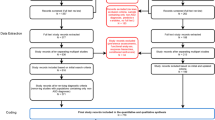Abstract
Prevalence rates of disruptive child behaviors, based on structured psychiatric interviews, are presented for samples of clinic-referred prepubertal boys at two sites to investigate differences and similarities among reports of the behaviors from children, parents, and teachers. Children reported significantly less hyperactive/inattentive and oppositional behaviors than either parents or teachers. In contrast, children did not differ from parents or teachers in their report on the prevalence of more serious conduct problems. These results were well replicated across two sites, despite the fact that there were significant differences between the sites in the level of hyperactive/inattentive child behaviors and conduct problems. The ranking of parents' and teachers' reported prevalence of specific child behavior problems in each of the three domains of disruptive behavior was strikingly similar. With one exception, the concordance between the prevalence ranking based on the children's reports was lower than that based on adults'reports, Children's reports on their own behavior did not predict various child handicaps 1 year later as well as did adults' reports. The results are discussed in relation to the usefulness of certain child behaviors in symptom lists for diagnostic purposes; the reliability of children's reports on their own behavior; and the possible reasons why prevalence rankings, as perceived by adults, are so similar.
Similar content being viewed by others
References
Achenbach, T. M., & Edelbrock, C. S. (1981). Behavioral problems and competencies reported by parents of normal and disturbed children aged four through sixteen.Monographs of the Society for Research in Child Development, 46, 1–82.
Achenbach, T. M., McConaughy, S. H., & Howell, C. T. (1987). Child-adolescent behavior and emotional problems: Implications of cross-informant correlation for situational specificity.Psychological Bulletin, 101, 213–232.
American Psychiatric Association. (1987).Diagnostic and statistical manual of mental disorders (3rd ed., revised). Washington, DC: Author.
Angold, A., Weissman, M. M., John, K., Merikangas, K. R., Prusoff, B. A., Wickramaratne, P., Gammon, G. D., & Warner, V. (1987). Parent and child reports of depressive symptoms in children at low and high risk of depression.Journal of Child Psychology and Psychiatry, 28, 901–915.
Cairns, S., & Cairns, B. D. (1984). Predicting aggressive patterns in girls and boys: A developmental study.Aggressive Behavior, 10, 227–242.
Costello, A. J., Edelbrock, C., Dulcan, M. K., Kalas, R., & Klaric, S. (1987).Diagnostic Interview Schedule for Children (DISC). Pittsburgh: Western Psychiatric Institute and Clinic, School of Medicine, University of Pittsburgh.
Edelbrock, C., Costello, A. J., Dulcan, M. K., Kalas, R., & Conover, N. C. (1985). Age differences in the reliability of the psychiatric interview of the child.Child Development, 56, 265–275.
Elliott, D. S., Huizinga, D., & Ageton, S. S. (1985).Explaining delinquency and drug use. Beverly Hills: Sage.
Gagnon, C., Vitaro, F., & Tremblay, R. (1990).Mothers' and teachers' perceptions of boys and girls behavior problems in kindergarten. Montreal: School of Psycho-education, University of Montreal.
Herjanic, B., & Reich, W. (1982). Development of a structured psychiatric interview for children: Agreement between child and parent on individual symptoms.Journal of Abnormal Child Psychology, 10, 307–324.
Johnston, L. D., Bachman, J. G., & O'Malley, P. M. (1982).Student drug use, attitudes and beliefs: National trends. Washington, DC: National Institute of Drug Use.
Keyes, S., & Block, J. (1984). Prevalence and patterns of substance use among early adolescents.Journal of Youth and Adolescence, 13, 1–14.
Loeber, R. (1987). The prevalence, correlates, and continuity of serious conduct problems in elementary school children.Criminology, 25, 615–642.
Loeber, R., Green, S. M., & Lahey, B. B. (1990). Mental health professionals' perceptions of the utility of children, parents, and teachers as informants on childhood psychopathology.Journal of Clinical Child Psychology, 19(2), 136–143.
Reich, W., & Earls, R. (1987). Rules for making psychiatric diagnosis in children on the basis of multiple sources of information: Preliminary strategies.Journal of Abnormal Psychology, 15, 601–616.
Richards, P., Berk, R. A., & Forster, B. (1979).Crime as play-delinquency in a middle class suburb. Cambridge, MA: Ballinger.
Robins, L. N. (1966).Deviant children grow up: A sociological and psychiatric study of sociopathic personality. Baltimore: Williams & Wilkins.
Robins, L. N., & Wish, E. (1977). Childhood deviance as a developmental process: A study of 223 urban black men from birth to 18.Social Forces, 56, 448–473.
Rutter, M. (1978). Family, area and school influences in the genesis of conduct disorders. In L. A. Hersov, M. Berger, & D. Shaffer (Eds.),Aggression and antisocial behavior in childhood and adolescence, (pp. 95–113). Oxford: Pergamon Press.
Rutter, M., Tizard, J., & Whitmore, K. (1970).Education, health and behavior. New York: Wiley.
Verhulst, F. C., & Akkerhuis, G. W. (1989). Agreement between parents' and teachers' ratings of behavioral/emotional problems of children aged 4-12.Journal of Child Psychology and Psychiatry, 30, 123–136.
Verhulst, F. C., Althaus, M., & Berden, F. M. G. (1987). The child assessment schedule: Parent child agreement and validity measures.Journal of Child Psychology and Psychiatry, 28, 455–466.
Vidoni, D. O., Fleming, N. J., & Mintz, S. (1983). Behavior problems of children as perceived by teachers, mental health professionals, and children.Psychology in the Schools, 96, 93–98.
Author information
Authors and Affiliations
Additional information
The authors are greatly indebted to Judith Navratil in seeking the cooperation of the subjects and in helping to collect high-quality data. Celia Nourse Batman very effectively assisted with editing the manuscript, and Debbie Tokar with preparing the references. The paper was written with financial support from grant MH42529 from the National Institute of Mental Health.
Rights and permissions
About this article
Cite this article
Loeber, R., Green, S.M., Lahey, B.B. et al. Differences and similarities between children, mothers, and teachers as informants on disruptive child behavior. J Abnorm Child Psychol 19, 75–95 (1991). https://doi.org/10.1007/BF00910566
Revised:
Issue Date:
DOI: https://doi.org/10.1007/BF00910566




